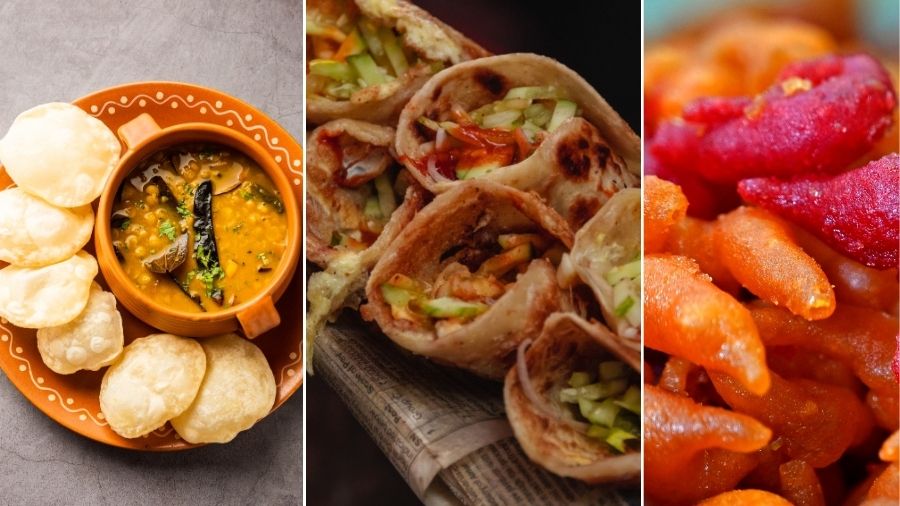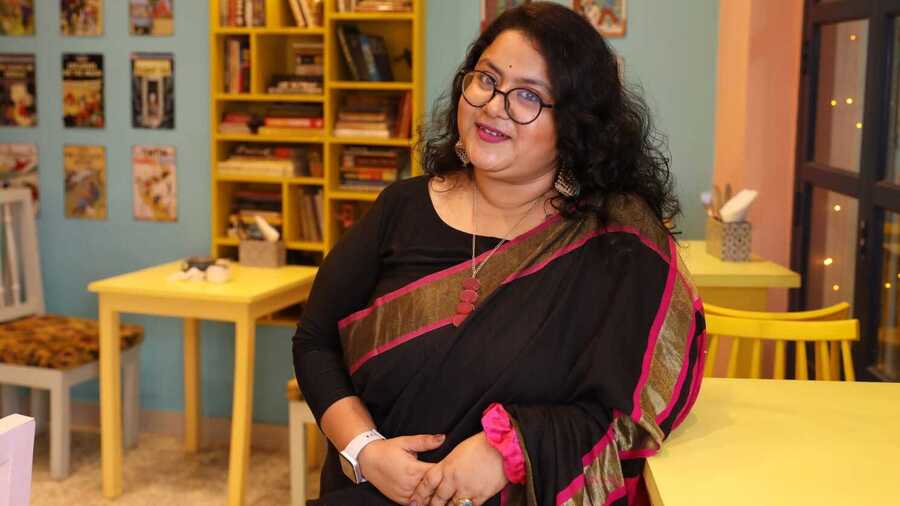Dyuti Banerjee fondly recalls her childhood memories of Durga Puja, the food cooked by her grandma and never failing to listen to Mahishasurmardini. The MasterChef India Season 7 contestant and owner of Calcutta Calorie shares with My Kolkata what Durga Puja means to her.
My Kolkata: Do you usually spend Durga Puja in Kolkata? Will you be visiting any pandals?
Dyuti Banerjee: I always spend Durga Puja in Kolkata. Staying away during pujo would mean missing out on the dhaak, pujo pujo gondho, and the dressing up which is to be inevitably marred by ghaam or brishti!
Pre-Covid, I used to have separate timetables for north and south Kolkata, plus a roster of comparatively less crowded places we could stop to eat at. Now, it is usually a couple of south Kolkata and Behala pandals, of which I never miss the entire line from Chetla Agrani to Badamtala Ashar Sangha, right up to Ballygunge Cultural, which is close to my best friend’s house. We continue to Samaj Sevi, Tridhara, and end at Singhi Park, Ekdalia and Durga Mandir. For Behala, I never miss Notun Dol, Barisha Club, though my favourite remains the bonedi barir pujo at Rajbari in Behala. This year, right after pujo, I am going on a short trip to Daringbadi, where I plan to cook up a storm by a waterfall!

Ballygunge Cultural Durga Puja remains one of Dyuti’s must-visit pandals every year Ashim Paul
Any special outfit(s) for Puja this year?
This year I have a surplus of new saris and a few new outfits too. For the saris, since I am a mul cotton bhakt, I bought quite a few from Gargi Chatterjee Dey. I also took full advantage of the Westside sale! I have two looks every pujo, one clad in a sari, in which look you will mostly find me in an adda at a south Kolkata cafe. The other is slightly dressy casual wear, or an ethnic dress, geared specially for pandal-hopping.
Is there a special event or tradition that you follow during Durga Puja?
The most important pujo I do before, during and after Puja, with the most ardent fervour, is pet pujo! I eat in the most egalitarian way, going from roadside stalls to the poshest restaurants!
Having lost my grandfather recently, I cannot take part in anjali and sandhi pujo this year, but there is something oddly alive about these two rituals, that even I, a very non-ritualistic person, feel connected to.
The other tradition I always follow is listening to Birendra Kishore Bhadra on Mahalaya. My grandmother, my Amma, introduced me to it, and now listening to it at 4am is my only way of connecting with her across space, time and lifetimes.
Do you have a special memory associated with Durga Puja in Kolkata or elsewhere?
I remember my first Mahalaya outside Kolkata, in Delhi. A cosy tight-knit group of Presidencians and JNUites got together in my one room set-up, cooked pulao, chicken and payesh for dinner, and stayed up all night just to catch Mahalaya. The radios on our phones decided not to work. I remember we downloaded the entire Mahalaya paath on our laptops and listened to it — the entire building deep in sleep, except for a handful of sleep-deprived Bengalis recreating home in a little room, propelled by a single magical voice.
The other stupendous moment, of course, was getting the news about being selected, that too on a Mahalaya afternoon, to go to Mumbai for the final MasterChef India audition round.
What is your favourite Durga Puja-time food?
Being born in a Bangal family, the yearlong obsession with food has always turned into manic proportions during pujo. For my Amma — the universe’s best chef in my heart — every living thought was about what her grandchildren would eat. Back when thakur dekha did not involve theme pujos, and Puja vacation was not accompanied by anxieties, we could afford to only think of what we would eat, starting the day with lal lal fulko luchi and an aloo peyaj morich er torkari cooked entirely in my grandmother’s specially procured ghee. There would invariably also be narkel kishmish dewa mishti chholar dal, a kishmish rich halwa, and huge quantities of mishti from either Sree Durga or Panna. There would be my Amma’'s legendary Bekti Machher Kofta curry on one of the days, together with a magical pulao that you could smell from 500 metres away! Mangsher jhol with a big aloo and slivered coconut slices were another of my favourite staples, my favourite piece being the ones with the kochkochi. Machher matha diye moonger dal, murighonto, machher teler bora, malpoa — these were also routine, but my favourite torkari had to be my Amma’s badhakopir torkari (cabbage sabzi) with tomatoes and ghee-fried eggs, though her fulkopir torkari and fulkopi dewa hasher dim er jhol (cauliflower curry and duck egg curry with cauliflower) were the crowd favourites. I know that if she were still around, I would not be eating out as much.

For Dyuti, Durga Puja is defined by food — her grandmother’s homemade ‘luchi-chholar daal’, rolls from roadside stalls and sweets like ‘bonde’ for neighbourhood shops Shutterstock, Amit Datta
The other favourite Pujo food used to be customary Bijoya-special plate with nimki naaru and pantua, which every house would offer the neighbours. I wonder where the tradition went when every household used to have an arsenal of nimkis and narkel naarus, and a fridge full of mishtis, ever prepared for guests who felt comfortable enough to drop by, always unannounced.
However, after I began gallivanting through the city during my college life, my favourite Durga Puja saviours became Thumsup and Fanta. With that a greasy juicy chicken roll, of course, plus some parar dokan bonde or rabri, and a giant cloud of pink candy floss. There is always endless chaa and shingaras. I sometimes drop into a nice restaurant or cafe that’s not too crowded, but I miss the pujos of my childhood the most.
One power of Durga you wish you had and why?
On a very light note, I wish I had a pet lion like Durga, because that’s heavy floof plus Z-class security in one! But seriously, I wish I had Ma Durga’s bright smile that lights up our hearts, that makes us wait a whole year for her, year after year, that washes away all sadness, bringing forth only strength and joy and peace. I wish I had the power to make everyone as happy as Ma Durga makes us, even if she visits for just four short days a year.
